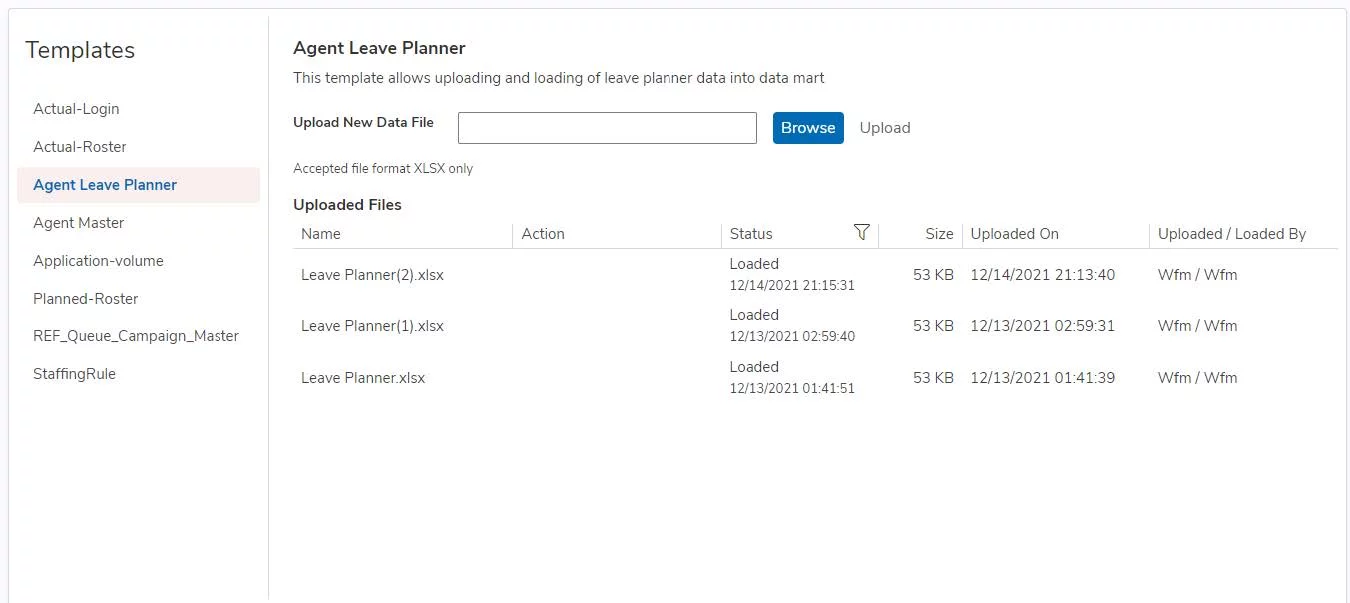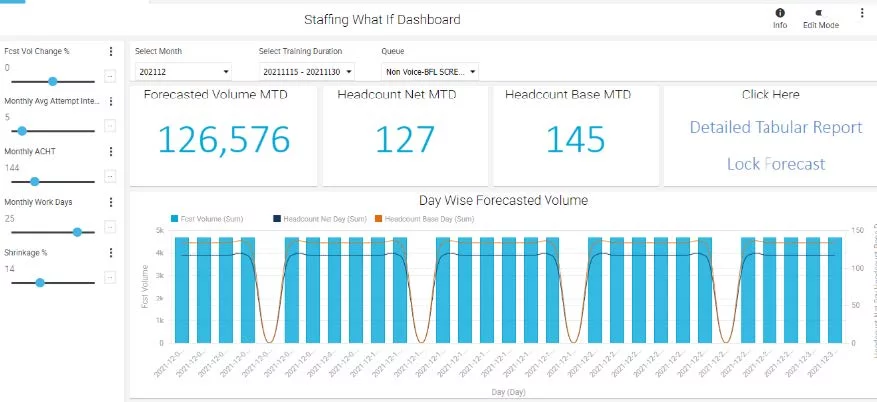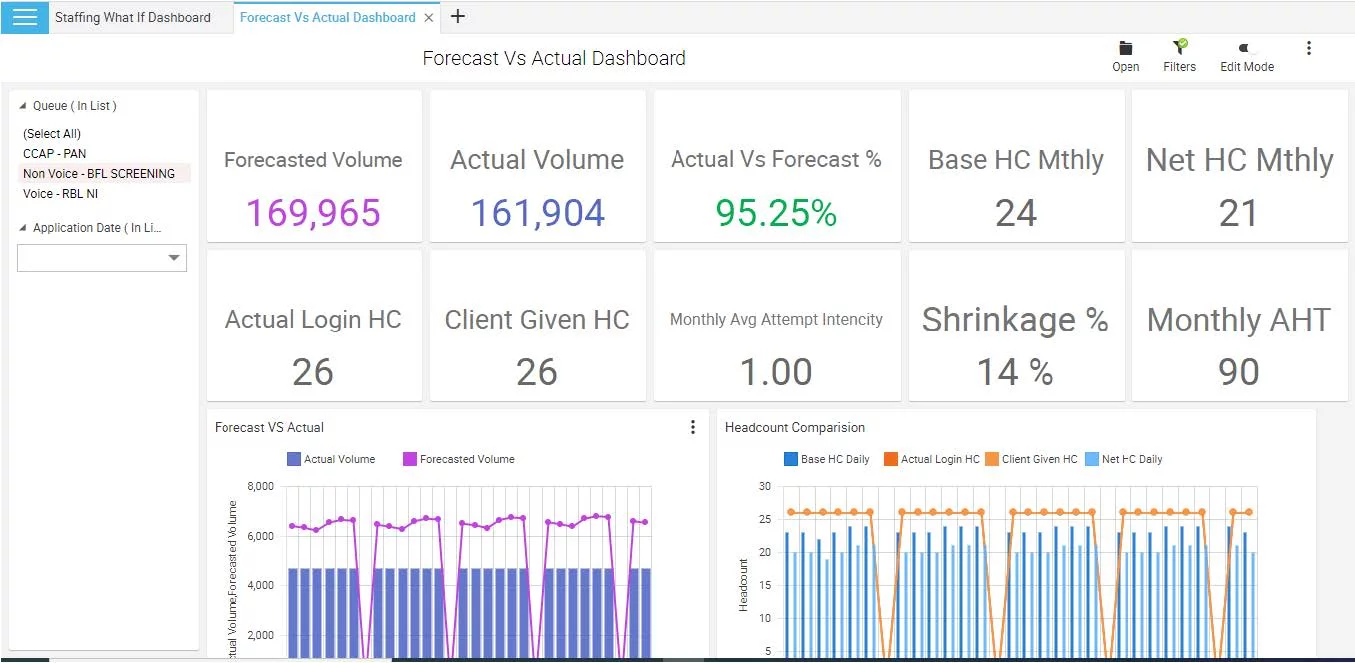At the humming 3i contact center, the workforce management team (WFM) is planning for the next month of operations for omnichannel business. Working on a fixed-FTE model, it is the team’s responsibility to find efficiencies for maximizing productivity while meeting their SLAs and revenue targets by rostering the optimal mix of multi-skilled resources. The team must also be geared to monitor key business KPIs and proactively optimize the floor to address any shortfalls.
3i Infotech offer a full spectrum of digital-first solutions, from back-office automation to business assurance and excellence services and an omni-channel platform for Digital CLM. Spanning all BPO communication channels and processes, 3i Infotech’s Digital BPS is one of the premier BPO companies in India.
The WFM team at 3i is the nerve center for 3i’s Digital CLM offering and bear the onus for business planning and revenue management. Their chief responsibility is ensuring that 3i meets its SLAs through effectively and accurately forecasting application volumes, planning capacity and scheduling rosters to support the operations team.
The Ask
3i approached Intellicus to build a WFM solution for a BFSI client for whom they provided support for three processes: outbound voice, non-voice process support and document processing of credit card applications. 3i supported outbound campaigns through calls and email for customer verification, curing and other campaign activities. This was supplemented by non-voice campaigns through document and transaction processing for screening, outreach to customers for missing information or additional details, validation and recommendations regarding approval of credit card applications.
3i wanted to improve their efficiency through an optimal mix of skill and billable headcount to meet the service levels for all the campaigns within each process.
Staffing was mandated by the bank and not based upon estimated application volumes. 3i wanted to accurately forecast the expected volume of applications for each of three processes they supported. They also wanted to evaluate staff count and plan for any attrition and to manage buffers. Multiskilling allocation was of special importance to 3i, to improve productivity, efficiency, competitiveness, quality and reduce costs.
Deployed in a hosted environment, the solution posed a challenge for 3i, who depended on local teams for access. Due to this dependence, accessing data and actioning insights derived from it was often delayed. The WFM team used spreadsheets and manually extracted, cleansed and collated data into them. They did not have forecasting as an action. Capacity planning and rostering of multi-skill agents was manual and took effort and time. Delays impacted hiring and training, affecting the full cycle of CLM.
Accuracy in forecasting for effective planning.
Efficiency in planning for shortening cycles.
Intelligent rostering to improve productivity.
Maximized profitability through multi-skilling.
FLOW breaks silos and gives WFM teams visibility into all their data.
FLOW has the capability to integrate with over 75+ data sources right out of the box. When that is not possible, such as in the hosted environment here, FLOW supports both ‘pushing’ files manually at fixed frequencies or scheduling a ‘pull’ from end destinations such as FTP, email etc. This is done as part of ETL through a custom-built middleware integrated into FLOW, which is an upload utility for integrating and consuming data.
FLOW’s upload utility employs customizable templates that can be tailored for any data source or data structure being consumed.
To enable 3i to directly access data at any time, Team Intellicus began with integrating historical data for each process to create a single source of truth. Since 3i’s BFSI client did not allow direct integration with their systems necessitating the use of the upload utility. Data was populated at the end source using the customized templates and raw files were pushed through the upload utility. Pushing raw files meant that the 3i MIS team did not need to clean or format the data as the upload utility performs data cleansing, rejecting any batch if any data is missing or mismatched.

FLOW infuses contact centers with AutoML to take the guesswork out of forecasting
Once 3i had historical data available for analysis, FLOW’s AutoML based module could help 3i in using it to forecast the expected application volume for each of the processes. The AutoML module can be trained over any period and the low-code/no-code feature allows any business user to exploit data science for making data-driven decisions. Users can control decisions like which algorithm to use from a choice of multiple modern and powerful options or can allow FLOW to automatically select one that is the best fit for their needs.
FLOW also allowed the 3i WFM team to simulate scenarios when planning capacity. FLOW gave the team a choice between methods and parameters for planning. The 3i team could choose between planning according to contractual thresholds or to use insights from historical data understand how it could impact their overall planning.
FLOW allows simulating multiple scenarios and combinations of KPIs for effective capacity planning for inbound, outbound, voice as well as non-voice use cases.
Through this powerful module, the team could manipulate KPIs like average call handling time, forecast volume change, attempt intensity and shrinkage due to absenteeism before finalizing both application volume prediction cycle and staffing parameters for a given prediction month. They could also improve efficiency by taking into consideration factors like the effect of seasonality and holidays on working days or attempt intensity.
Once the team had arrived at the desired efficiency level, the forecast was then locked and the predictions used for planning the workforce for the upcoming month.

Once work for the month had been finished, the 3i team also used FLOW to compare the forecast with the actual volume to evaluate KPIs critical for the business. This gave the team insights into the machine learning based forecasts generated by FLOW and helped them gauge the accuracy of the forecast. It also gave data to analyze the headcount they had required and to compare it against base as well as the actual login.

In addition to planning more effectively, the WFM could now also shift focus to evaluating business performance and proactively driving efficiencies. FLOW presented complete view of their productivity through convenient and graphical smart reports on a single dashboard. The team also had an option to interact with the dashboard and drill it down to a level where they can view details for each of the skills.
Available on a T-1 basis, through this comparison the team could quickly understand how the business was behaving. Secondly, it gave them an understanding of the areas where they need to concentrate upon to improve overall performance. Lastly, it presented a quick snapshot on whether they would be able to achieve the intended revenue target.
FLOW helps WFM teams improve resource management through intelligent rostering
Once the forecast was locked for a process, the data was then also used for rostering. The WFM team used FLOW to build intelligent rosters with the right mix of multi-skilled talent. FLOW helped the WFM team in eliminating manual, repetitive and tedious tasks by leveraging the power of AI. The solution also built social and human intelligence into the roster by factoring in business rules, employee performance, leaves, special timings for women and many other complexities.
FLOW gave the 3i team the roster for the week in three flavors. The first was the roster generated by FLOW’s rostering module after accommodating all the social and human rules. Next, FLOW allowed the operations team to customize this roster on the basis of the changes they want to make to create the ‘planned roster’. Thirdly, the ‘actual roster’ was generated post-facto to reflect the actual adherence on the floor. FLOW supports the frequency for the actual roster from a few minutes after a shift, daily, weekly or any other frequency.

By comparing the planned and actual rosters and scheduling plotter reports, the WFM team could get a clear understanding of the adherence, hours logged and revenue generated which could help them in quickly and proactively optimize the business.
FLOW allows users to choose between real-time and historical comparisons of scheduling reports to understand what and where the shortfall or excess is and assess the best ways to address the billing requirements.
Changing the game with FLOW
With FLOW, 3i changed the way a fixed FTE business worked and in a first, used forecasting to plan and optimize operations. 3i found the perfect balance between meeting SLAs and omnichannel optimal staffing. It freed the 3i WFM team from tedious, manual and repetitive tasks so that they could focus on improving productivity and maximizing revenue by planning the right number and type of multi-skilled shifts and address scheduling leakages and irregularities. With FLOW, 3i can ensure wins for its WFM managers, supervisors and agents along with delight for its customers.
To learn how FLOW can help BPMs boost profitability and customer delight, connect with us at www.flowwfm.com/schedule-demo